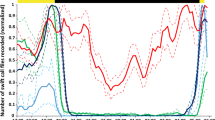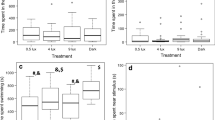Abstract
A variety of ecologically important behaviors, including circadian rhythms and seasonal reproduction, are influenced by non-visual responses to light, yet very little is known about the relationship between photic habitat and non-visual photoreception. Puerto Rican Anolis lizards have diverged into multiple photic niches, making them a good model for non-visual photosensory ecology. We investigated the photic induction of locomotor activity, a non-visual response to light, in four species of Anolis comprising two pairs of closely related, ecomorphologically similar species whose microhabitats differ in solar irradiance. We developed a device for continuous, automated detection and recording of anole locomotor activity, and used it to characterize activity under 12:12 h light–dark cycles. Next, we administered a series of 2-h light pulses during the dark period of the light–dark cycle and measured the increase in locomotor activity relative to baseline dark activity. Five different irradiances (ranging from very dim to daytime levels) were given to each individual lizard on separate nights. As expected, light caused an irradiance-dependent increase in locomotor activity in all four species. The responses at the highest irradiances were significantly greater in species occupying relatively more shaded habitats, suggesting that non-visual photoreception may be adapted to habitat light in Anolis lizards.





Similar content being viewed by others
References
Chiesa JJ, Aguzzi J, Garcia JA, Sarda F, de la Iglesia HO (2010) Light intensity determines temporal niche switching of behavioral activity in deep-water Nephrops norvegicus (Crustacea: Decapoda). J Biol Rhythm 25:277–287
Collin SP (2010) Evolution and ecology of retinal photoreception in early vertebrates. Brain Behav Evol 75:174–185
Do MT, Yau KW (2010) Intrinsically photosensitive retinal ganglion cells. Physiol Rev 90:1547–1581
Endler JA (1992) Signals, signal conditions, and the direction of evolution. Am Nat 139(Suppl):S125–S153
Endler JA (1993) The color of light in forests and its implications. Ecol Monogr 63:2–27
Endler JA, Westcott DA, Madden JR, Robson T (2005) Animal visual systems and the evolution of color patterns: sensory processing illuminates signal evolution. Evolution 59:1795–1818
Fernandez-Duque E, de la Iglesia H, Erkert HG (2010) Moonstruck primates: owl monkeys (Aotus) need moonlight for nocturnal activity in their natural environment. PLoS One 5:e12572
Fleishman LJ, Bowman M, Saunders D, Miller WE, Rury MJ, Loew ER (1997) The visual ecology of Puerto Rican anoline lizards: habitat light and spectral sensitivity. J Comp Physiol A 181:446–460
Fraker ME (2008) The influence of the circadian rhythm of green frog (Rana clamitans) tadpoles on their antipredator behavior and the strength of the nonlethal effects of predators. Am Nat 171:545–552
Fu Y, Liao HW, Do MT, Yau KW (2005) Non-image-forming ocular photoreception in vertebrates. Curr Opin Neurobiol 15:415–422
Gerrish GA, Morin JG, Rivers TJ, Patrawala Z (2009) Darkness as an ecological resource: the role of light in partitioning the nocturnal niche. Oecologia 160:525–536
Gotelli NJ, Graves GR (1996) Null models in ecology. Smithsonian Institution Press, Washington
Hattar S, Lucas RJ, Mrosovsky N, Thompson S, Douglas RH, Hankins MW, Lem J, Biel M, Hofmann F, Foster RG, Yau KW (2003) Melanopsin and rod-cone photoreceptive systems account for all major accessory visual functions in mice. Nature 424:76–81
Hertz PE, Fleishman LJ, Armsby C (1994) The influence of light intensity and temperature on microhabitat selection in two Anolis lizards. Funct Ecol 8:720–729
Hoffmann K (1969) Zum Einfluss der Zeitgeberstärke auf die Phasenlage der synchronisierten circadianen Periodik. Z Vergl Physiol 62:93–110
Huey RB, Webster TP (1976) Thermal biology of Anolis lizards in a complex fauna: the Cristatellus group on Puerto Rico. Ecology 57:985–994
Hutchinson GE (1957) Concluding remarks. In: Cold spring habor symposia on quantitative biology, vol 22, pp 415–427
Hyde LL, Underwood H (2000) Effects of melatonin administration on the circadian activity rhythm of the lizard Anolis carolinensis. Physiol Behav 71:183–192
Kronfeld-Schor N, Dayan T (2003) Partitioning of time as an ecological resource. Annu Rev Ecol Evol Syst 34:153–181
Kronfeld-Schor N, Dayan T, Elvert R, Haim A, Zisapel N, Heldmaier G (2001) On the use of the time axis for ecological separation: diel rhythms as an evolutionary constraint. Am Nat 158:451–457
Leal M, Fleishman LJ (2002) Evidence for habitat partitioning based on adaptation to environmental light in a pair of sympatric lizard species. Proc Biol Sci 269:351–359
Levri EP, Lunnen SJ, Itle CT, Mosquea L, Kinkade BV, Martin TG, DeLisser MA (2007) Parasite-induced alteration of diurnal rhythms in a freshwater snail. J Parasitol 93:231–237
Loew ER, Fleishman LJ, Foster RG, Provencio I (2002) Visual pigments and oil droplets in diurnal lizards: a comparative study of Caribbean anoles. J Exp Biol 205:927–938
Losos JB (1990) Ecomorphology, performance capability, and scaling of West-Indian Anolis lizards—an evolutionary analysis. Ecol Monogr 60:369–388
Losos JB (2009) Lizards in an evolutionary tree: the ecology of adaptive radiation in anoles. University of California Press, Berkeley
Lythgoe JN (1979) The ecology of vision. Oxford University Press, New York
Lythgoe JN (1984) Visual pigments and environmental light. Vis Res 24:1539–1550
Maan ME, Seehausen O (2010) Mechanisms of species divergence through visual adaptation and sexual selection: perspectives from a cichlid model system. Curr Zool 56:285–299
Marques MD, Waterhouse JM (1994) Masking and the evolution of circadian rhythmicity. Chronobiol Int 11:146–155
Moore AF, Menaker M (2011) The effect of light on melatonin secretion in the cultured pineal glands of Anolis lizards. Comp Biochem Physiol A 160:301–308
Mrosovsky N (1999) Masking: history, definitions, and measurement. Chronobiol Int 16:415–429
Narendra A, Reid SF, Hemmi JN (2010) The twilight zone: ambient light levels trigger activity in primitive ants. Proc R Soc B 277:1531–1538
Nicholson K, Glor R, Kolbe J, Larson A, Hedges S, Losos JB (2005) Mainland colonization by island lizards. J Biogeogr 32:929–938
Orpwood JE, Griffiths SW, Armstrong JD (2006) Effects of food availability on temporal activity patterns and growth of Atlantic salmon. J Anim Ecol 75:677–685
Page TL (1989) Masking in invertebrates. Chronobiol Int 6:3–11
Peirson SN, Halford S, Foster RG (2009) The evolution of irradiance detection: melanopsin and the non-visual opsins. Phil Trans R Soc Lond B 364:2849–2865
Rand AS (1964) Ecological distribution in anoline lizards of Puerto Rico. Ecology 45:745–752
Reebs SG (2002) Plasticity of diel and circadian activity rhythms in fishes. Rev Fish Biol Fisher 12:349–371
Underwood H (1986) Light at night cannot suppress pineal melatonin levels in the lizard Anolis carolinensis. Comp Biochem Physiol A 84:661–663
Underwood H, Hyde LL (1989) The effect of daylength on the pineal melatonin rhythm in the lizard Anolis carolinensis. Comp Biochem Physiol A 94:53–56
Valeix M (2009) Does the risk of encountering lions influence African herbivore behaviour at waterholes? Behav Ecol Sociobiol 63:1483–1494
Walls GL (1942) The vertebrate eye and its adaptive radiation. Cranbrook Institute of Science, Bloomfield Hills
Warrant E (2004) Vision in the dimmest habitats on earth. J Comp Physiol A 90:765–789
Williams EE (1972) The origin of faunas. Evolution of lizard congeners in a complex island fauna: a trial analysis. Evol Biol 6:47–89
Williams EE (1983) Ecomorphs, faunas, island size, and diverse endpoints in island radiations of Anolis. Harvard University Press, Cambridge
Ziv Y, Abramsky Z, Kotler BP, Subach A (1993) Interference competition and temporal and habitat partitioning in two gerbil species. Oikos 66:237–246
Acknowledgments
Funding for this project was provided by the National Science Foundation (Doctoral Dissertation Improvement Grant 0910075 to AFM, MM, and E. Brodie III) and the University of Virginia (Center and Labs Union Technology Grant to AFM). The authors thank the Departamento de Recursos Naturales y Ambientales of Puerto Rico for permission to collect animals for this study (DRNA permit 2009-IC-025). All procedures were approved by the University of Virginia Animal Care and Use Committee. Special thanks goes to Y. Kawasaki for the construction of activity enclosures and sensor circuits and to D. Mills for videography analysis and calibration of the recording system. We are grateful to D. Carr for providing invaluable statistical advice. We also thank E. Liebgold, P. Bartell, H. Vasaly, and S. Steiner for assistance with animal capture, as well as undergraduate assistants M. Fredericksen, E. Wrona, and R. Ababio for help with animal care. L. Avila, T. Ransom, K. Burke, and two anonymous reviewers offered helpful suggestions that improved the quality of this manuscript.
Author information
Authors and Affiliations
Corresponding author
Rights and permissions
About this article
Cite this article
Moore, A.F., Kawasaki, M. & Menaker, M. Photic induction of locomotor activity is correlated with photic habitat in Anolis lizards. J Comp Physiol A 198, 193–201 (2012). https://doi.org/10.1007/s00359-011-0699-5
Received:
Revised:
Accepted:
Published:
Issue Date:
DOI: https://doi.org/10.1007/s00359-011-0699-5




